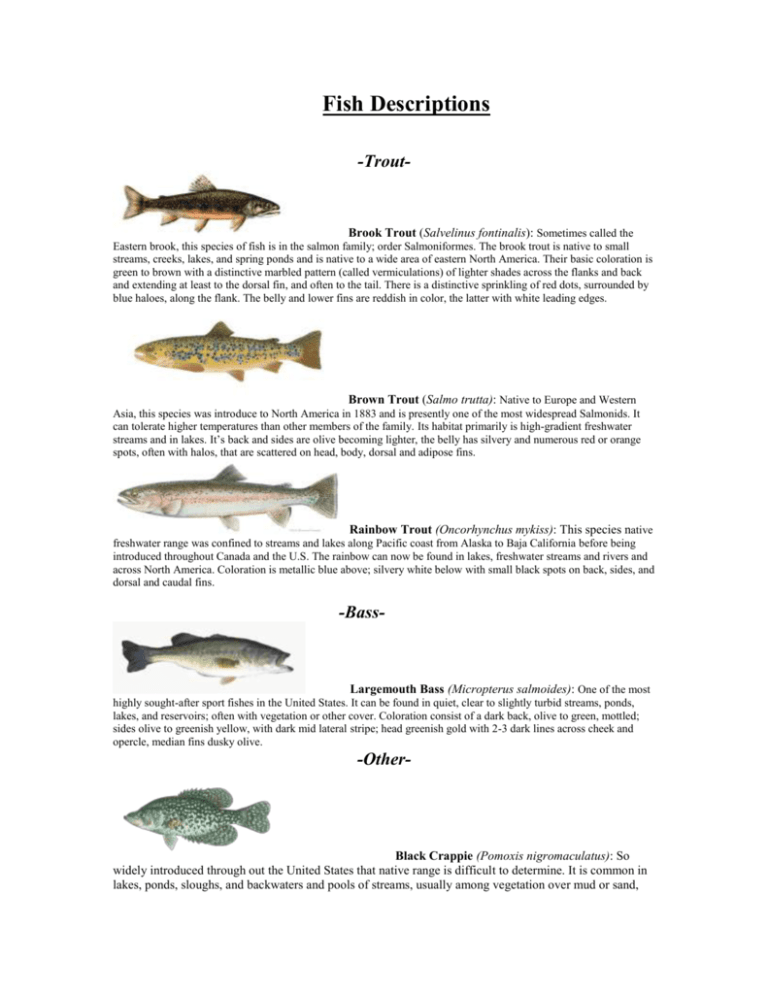Fish Descriptions - Otsego County Soil and Water Conservation
advertisement

Fish Descriptions -Trout- Brook Trout (Salvelinus fontinalis): Sometimes called the Eastern brook, this species of fish is in the salmon family; order Salmoniformes. The brook trout is native to small streams, creeks, lakes, and spring ponds and is native to a wide area of eastern North America. Their basic coloration is green to brown with a distinctive marbled pattern (called vermiculations) of lighter shades across the flanks and back and extending at least to the dorsal fin, and often to the tail. There is a distinctive sprinkling of red dots, surrounded by blue haloes, along the flank. The belly and lower fins are reddish in color, the latter with white leading edges. Brown Trout (Salmo trutta): Native to Europe and Western Asia, this species was introduce to North America in 1883 and is presently one of the most widespread Salmonids. It can tolerate higher temperatures than other members of the family. Its habitat primarily is high-gradient freshwater streams and in lakes. It’s back and sides are olive becoming lighter, the belly has silvery and numerous red or orange spots, often with halos, that are scattered on head, body, dorsal and adipose fins. Rainbow Trout (Oncorhynchus mykiss): This species native freshwater range was confined to streams and lakes along Pacific coast from Alaska to Baja California before being introduced throughout Canada and the U.S. The rainbow can now be found in lakes, freshwater streams and rivers and across North America. Coloration is metallic blue above; silvery white below with small black spots on back, sides, and dorsal and caudal fins. -Bass- Largemouth Bass (Micropterus salmoides): One of the most highly sought-after sport fishes in the United States. It can be found in quiet, clear to slightly turbid streams, ponds, lakes, and reservoirs; often with vegetation or other cover. Coloration consist of a dark back, olive to green, mottled; sides olive to greenish yellow, with dark mid lateral stripe; head greenish gold with 2-3 dark lines across cheek and opercle, median fins dusky olive. -Other- Black Crappie (Pomoxis nigromaculatus): So widely introduced through out the United States that native range is difficult to determine. It is common in lakes, ponds, sloughs, and backwaters and pools of streams, usually among vegetation over mud or sand, most common in clear water. Upper body consists of a grey-green color with wavy black bands, green flecks on silver-blue side; white below, many wavy black bands, spots on dorsal caudal and anal fins Channel Catfish (Ictalurus punctatus): This species of catfish is a very popular sport and food fish and is a principal catfish raised in aquaculture. It can be found in large creeks and rivers with slow to moderate current over sand, gravel, or rocks; ponds; lakes; and reservoirs. Coloration consists of black bluish gray and its sides are light blue to silvery with scattered patches that run dark olive to dusky. Grass Carp (Ctenopharyngodon idella): This carp, native to eastern Asia, was introduced to experimental ponds in Alabama and Arkansas in 1963 for aquatic weed control and as a food source. Subsequently, breeding populations were found to be invasive and permits are required for stocking in New York. The Grass Carp can be found in rivers and large creeks and it is adaptable to ponds and reservoirs. The coloration on its back is olive brown; its side’s are silvery; whitish below; fins olive to dusky. Yellow Perch (Perca flavescens): Yellow Perch live in schools in deep water, moving into shallower areas to feed at dawn and dusk. They can be found in open areas in clear streams, lakes, ponds, and reservoirs with aquatic vegetation. The coloration is brassy green to golden yellow above. It has 5-8 dusky bars across back almost to belly; dorsal and caudal fins light grayish green to reddish orange. Fathead Minnows (Pimephales promelas): Often sold as bait, this species is easily propagated in small ponds and may yield 400,000 fish per acre. Fathead Minnows can be found in clear pools of creeks and shallow ponds and lakes over sand, gravel, or mud. The coloration of the back is tan to olive; sides silvery to brassy; caudal spot dark. Breeding males grayish black, with pale fleshy pad behind head; pale below dorsal fin. -Habitat ConditionsTrout 1. Brookies 2. Brown’s 3. Rainbow’s Stocking rates 300-400/ acre - Trout are a cool/cold water species. Generally, the pond 200-300/ acre should not be shallower then 12 feet. Water temperature 400-500/acre should not exceed 60-65 oF at the bottom of your pond Bass Large/Smallmouth 75-100/acre Fathead Minnow 750-1000/acre Yellow Perch 1-200/acre Channel Catfish 1-200/acre Grass Carp 10+ -Bass DO NOT!!, do well with commercial food. When stocking a bass pond with a forage fish it is important that they have cover to breed and hide in, such as grass, cattails, weeds, etc (Depending on specification of permit) (All information gathered about these fish were found in the 2002 addition of the National Audubon Society Field Guide to Fishes North America)









